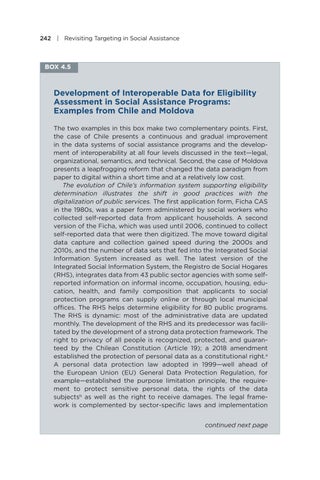242 | Revisiting Targeting in Social Assistance
BOX 4 .5
Development of Interoperable Data for Eligibility Assessment in Social Assistance Programs: Examples from Chile and Moldova The two examples in this box make two complementary points. First, the case of Chile presents a continuous and gradual improvement in the data systems of social assistance programs and the development of interoperability at all four levels discussed in the text—legal, organizational, semantics, and technical. Second, the case of Moldova presents a leapfrogging reform that changed the data paradigm from paper to digital within a short time and at a relatively low cost. The evolution of Chile’s information system supporting eligibility determination illustrates the shift in good practices with the digitalization of public services. The first application form, Ficha CAS in the 1980s, was a paper form administered by social workers who collected self-reported data from applicant households. A second version of the Ficha, which was used until 2006, continued to collect self-reported data that were then digitized. The move toward digital data capture and collection gained speed during the 2000s and 2010s, and the number of data sets that fed into the Integrated Social Information System increased as well. The latest version of the Integrated Social Information System, the Registro de Social Hogares (RHS), integrates data from 43 public sector agencies with some selfreported information on informal income, occupation, housing, education, health, and family composition that applicants to social protection programs can supply online or through local municipal offices. The RHS helps determine eligibility for 80 public programs. The RHS is dynamic: most of the administrative data are updated monthly. The development of the RHS and its predecessor was facilitated by the development of a strong data protection framework. The right to privacy of all people is recognized, protected, and guaranteed by the Chilean Constitution (Article 19); a 2018 amendment established the protection of personal data as a constitutional right.a A personal data protection law adopted in 1999—well ahead of the European Union (EU) General Data Protection Regulation, for example—established the purpose limitation principle, the requirement to protect sensitive personal data, the rights of the data subjectsb as well as the right to receive damages. The legal framework is complemented by sector-specific laws and implementation continued next page


